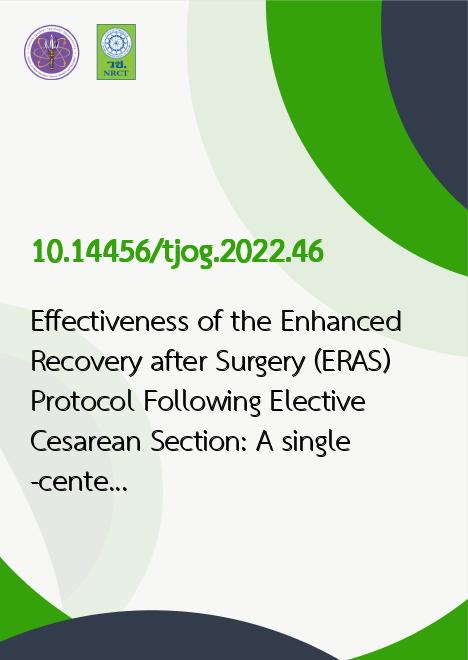
|
Effectiveness of the Enhanced Recovery after Surgery (ERAS) Protocol Following Elective Cesarean Section: A single-center randomized controlled trial |
|---|---|
| รหัสดีโอไอ | |
| Creator | Nutchar Klangprapan |
| Title | Effectiveness of the Enhanced Recovery after Surgery (ERAS) Protocol Following Elective Cesarean Section: A single-center randomized controlled trial |
| Contributor | Amarin Narkwichean, Jutarat Luanpholcharoenchai, Wipada Laosooksathit |
| Publisher | PIMDEE Co., Ltd. |
| Publication Year | 2565 |
| Journal Title | Thai Journal of Obstetrics and Gynaecology |
| Journal Vol. | 30 |
| Journal No. | 6 |
| Page no. | 393-402 |
| Keyword | cesarean section, enhancing recovery, quality of recovery, pain |
| URL Website | https://tci-thaijo.org/index.php/tjog/index |
| Website title | www.tci-thaijo.org |
| ISSN | 2673-0871 |
| Abstract | Objectives: To compare 24 hours postoperative recovery utilizing the quality of recovery questionnaire (QoR-35, Thai version) and pain assessment using the visual analogue scale (VAS) between pregnant women scheduled for elective cesarean section receiving enhanced recovery after surgery (ERAS) and standard protocol. Materials and Methods: A randomized controlled trial was performed in 48 singleton pregnancy patients scheduled for elective cesarean section using the ERAS protocol and the standard protocol at HRH Princess Maha Chakri Sirindhorn Medical Center (MSMC). The 24-hour postoperative recovery and pain score were assessed to compare postoperative recovery. Postoperative complications after 72 hours postpartum were compared between two protocols. Results: A total of 48 term-pregnant women were included in the study. Five women were excluded, leaving 43 participants (21 participants in the ERAS protocol group and 22 participants in the standard protocol group). As per the protocol analyses, the median (interquartile range (IQR)) of QoR-35 scores were 153.7 (? 10.2) and 149 (? 32), p = 0.20 in the ERAS group and standard group, respectively. The mean (? standard deviation (SD)) pain scores 24-hours postoperatively were 3.1 (?1.9) and 5.1 (?1.9), p < 0.05 in the ERAS and standard protocol groups, respectively. There was no postoperative complication reported.Conclusion: There was no statistically significant difference between QoR-35 scores. However, the pain dimension with the ERAS protocol was significantly lower than in the standard care group and no complications were found 72 hours after surgery. The study found that the ERAS protocol was able to significantly reduce postoperative pain without increasing the negative impact on the surgical outcome. |